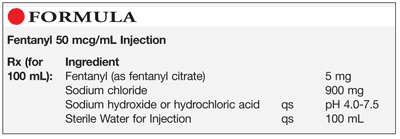US Pharm. 2012;37(8):45-46.

Method of Preparation: Note—This preparation should be compounded in a laminar airflow hood in a cleanroom or via isolation barrier technology by a validated aseptic compounding pharmacist using strict aseptic technique. This is a high-risk preparation.
Calculate the required quantity of each ingredient for the total amount to be prepared. Accurately weigh or measure each ingredient. Dissolve the fentanyl citrate and sodium chloride in about 95 mL of Sterile Water for Injection. Adjust the pH to 4 to 7.5 with either sodium hydroxide or hydrochloric acid. Add sufficient Sterile Water for Injection to final volume and mix well. Filter the mixture through a sterile 0.22-µm filter into a sterile syringe, cassette, or other appropriate container. Package and label.
Use: Fentanyl citrate injection is used in the treatment of moderate-to-severe pain.
Packaging: Package preparation in appropriate sterile single-use containers.1
Labeling: Keep out of the reach of children. Use only as directed. Protect from light.1
Stability: If no sterility-testing program is in place, a beyond-use date of up to 24 hours may be used if the preparation is stored at controlled room temperature, 3 days if stored in a refrigerator, or 45 days in solid frozen state at –25°C to –10°C or colder. If a sterility-testing program is in place, a beyond-use date of up to 6 months may be used for this preparation.1
Quality Control: Quality-control assessment can include weight/volume, physical observation, pH (4.0-7.5), specific gravity, osmolality, assay, color (colorless), clarity (clear), particulate matter, sterility, and pyrogenicity (not more than 50.0 USP EU/mg).2,3
Discussion: Fentanyl citrate injection, which is commercially manufactured, is currently included on the “drugs in short supply” list. It may be compounded to meet the needs of patients, hospitals, and health care providers during this time of shortage.
Fentanyl citrate (C22H28N2O.C6H8O7, MW 528.6) occurs as white granules or as a white, crystalline powder. Fentanyl citrate 157 mcg is approximately equal to 100 mcg of fentanyl. It is soluble 1 g in 40 mL of water and is slightly soluble in alcohol. The pH of fentanyl injection is in the range of 4.0 to 7.5. Fentanyl citrate is a synthetic opioid analgesic used as a sedative, analgesic, preoperative medication, and adjunct to general or regional anesthesia, as well as in the management of chronic pain.4
Sodium chloride injection 0.9% contains not less than 95.0% and not more than 105.0% of the labeled amount of sodium chloride in Water for Injection. It has a pH between 4.5 and 7.0 and contains no added antimicrobial agents. Sodium chloride solutions are chemically and physically stable. They may be sterilized by filtration or autoclaving. Sodium chloride is soluble in water to the extent of 1 g in 2.8 mL of water, and it is slightly soluble in alcohol (1 g in 250 mL of 95% ethanol).5
Sodium chloride (MW 58.44) is available as a white, crystalline powder or as colorless crystals. It has a saline taste and is used in a variety of parenteral and nonparenteral pharmaceutical formulations. In parenteral, ophthalmic, and nasal preparations, sodium chloride is used to prepare isotonic solutions. Used as a capsule diluent and as a lubricant, it also is used to control drug release from some microcapsules, to control micelle size, and to adjust the viscosity of some polymer dispersions by altering the ionic character of the formulation. A saturated solution has a pH in the range of 6.7 to 7.3. A 0.9% w/v aqueous solution is iso-osmotic with serum, and its solutions are stable.6
Sterile Water for Injection is Water for Injection that has been sterilized and suitably packaged; it contains no added substances. Water for Injection is water that has been purified by distillation or reverse osmosis and contains no added substances. Note that Water for Injection is not prepared by an ion-exchange process. Water has a specific gravity of 0.9971 at room temperature, a melting point of 0°C, and a boiling point of 100°C. Water is miscible with most polar solvents and is chemically stable in all physical states (ice, liquid, and steam).6
REFERENCES
1. U.S. Pharmacopeia 35/National Formulary 30. Rockville, MD: U.S. Pharmacopeial Convention, Inc; 2012;344-386,3169-3170.
2. Allen LV Jr. Standard operating procedure for particulate testing for sterile products. IJPC. 1998;2:78.
3. Allen LV Jr. Standard operating procedure: quality assessment for injectable solutions. IJPC. 1999;3:406-407.
4. Reynolds JEF, ed. Martindale: The Extra Pharmacopoeia. 30th ed. London, England: Pharmaceutical Press; 1993:1076-1077.
5. Maximilien JS. Sodium chloride. In: Rowe RC, Sheskey PJ, Quinn ME, eds. Handbook of Pharmaceutical Excipients. 6th ed. London, England: Pharmaceutical Press; 2009:637-640.
6. Dubash D, Shah U. Water. In: Rowe RC, Sheskey PJ, Quinn ME, eds. Handbook of Pharmaceutical Excipients. 6th ed. London, England: Pharmaceutical Press; 2009:766-770.
To comment on this article, contact rdavidson@uspharmacist.com.





